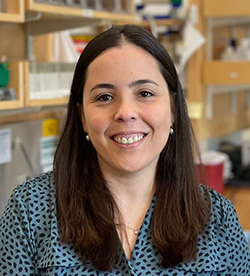Ana Arruda

Assistant Professor (Affiliated) of Cell Biology, Development and Physiology
Lab Homepage: https://arrudalab.orgResearch Interests
Metabolic adaptation in response to nutritional fluctuations is essential to maintain organismal homeostasis. Many processes supporting metabolic adaptation to transient changes in nutrient availability occur at the level of intracellular organelles such as the endoplasmic reticulum (ER). The ER controls essential processes in the cells such as protein translation, folding and secretion, lipid biosynthesis, glucose metabolism and is the main site of Ca2+ storage in the cells.
ER structure is complex and comprises a network of interconnected membranes organized as flat sheets and tubules which maintain physical contact sites with every other organelle in the cell. ER structure and function are highly dynamic especially in metabolic cells such as liver and intestine, that completely shift metabolism during nutritional changes such as in fasting and feeding. However, ER fails to adapt to chronic metabolic stress imposed by obesity and metabolic syndrome. ER dysfunction in obesity is one of the pivotal mechanisms associated with obesity-driven metabolic diseases such as insulin resistance, diabetes, atherosclerosis and fatty liver disease, which are major public health problems worldwide.
Research in Arruda lab aims to understand how remodeling of the ER structure and contact sites with other organelles translate in alterations in metabolic regulation during nutritional fluctuations in physiology and metabolic diseases.
Some of the main questions we want to address are:
- How do the remodeling of organelle architecture and inter-organelle communication allow cells and tissues to adapt to nutritional challenges such as fasting and feeding cycles?
- What are the signals that control organelle architecture in metabolic tissues?
- What are the functional implications of organelle remodeling and contact sites for systemic metabolic regulation?
- Can we target organelle structure and function genetically or pharmacologically to treat metabolic diseases such as diabetes and fatty liver disease?
To learn more about our research, visit our website: https://www.arrudalab.org
Selected Publications
- Arruda, A.P. $ & Parlakgul, G. The role of ER architecture in metabolic health and disease. Cold Spring Harbor Perspectives in Biology, a041261, 2022. $Corresponding author.
- Parlakgul, G.*, Arruda, A.P.*, Pang, S., Cagampan, E., Guney, E., Lee Y., Inouye, K, Hess H., Xu, S. and Hotamisligil, G.S. Regulation of liver subcellular architecture controls metabolic homeostasis Nature, 603 (7902):736-742, 2022. *These authors contributed equally to this work.
- Guney, E.*, Arruda, A.P*$, Parlakgul, G., Cagampan, E., Min, N., Lee, Y., Greene, L., Tsaousidou, E., Inouye, K., Sook Han, M., Davis, R.J., Hotamisligil, G.S.$ Aberrant Ca2+ homeostasis in adipocytes links inflammation to metabolic dysregulation in obesity. Science Signaling,14 (713):eabf 2059, 2021. *These authors contributed equally to this work $Corresponding authors.
- Arruda, A.P.*, Pers, B.M.*, Parlakgul, G., Güney, E., Goh, T., Cagampan, E., Lee, Y.G., Goncalves, R.L., Hotamisligil, G.S. Defective STIM-mediated store operated Ca2+ entry in hepatocytes leads to metabolic dysfunction in obesity. eLife, Dec 15;6, 2017. *These authors contributed equally to this work.
- Arruda, A.P., Hotamisligil, G.S. Organelle calcium homeostasis in metabolic disease. Cell Metabolism, 22:381-97, 2015.
- Arruda A.P.* Pers B.M.*, Parlakgul G., Guney E., Inouye K., Hotamisligil G.S. Chronic enrichment of hepatic endoplasmic reticulum-mitochondria contact leads to mitochondrial dysfunction in obesity. Nature Medicine, 20:1427-35, 2014. *These authors contributed equally to this work (Cover of the Nature Medicine’s December 2014 issue).
See complete list of publications in Google Scholar
Last Updated 2023-06-23